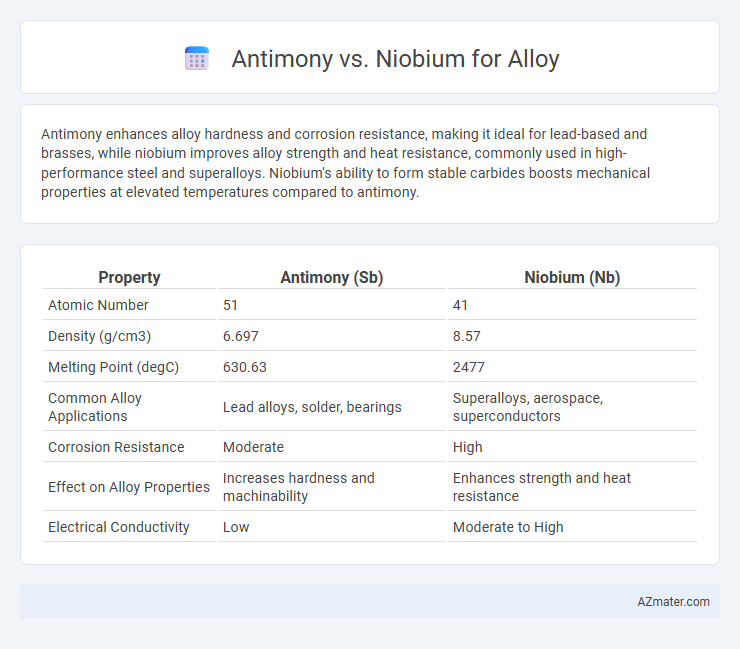Antimony enhances alloy hardness and corrosion resistance, making it ideal for lead-based and brasses, while niobium improves alloy strength and heat resistance, commonly used in high-performance steel and superalloys. Niobium's ability to form stable carbides boosts mechanical properties at elevated temperatures compared to antimony.
Table of Comparison
| Property | Antimony (Sb) | Niobium (Nb) |
|---|---|---|
| Atomic Number | 51 | 41 |
| Density (g/cm3) | 6.697 | 8.57 |
| Melting Point (degC) | 630.63 | 2477 |
| Common Alloy Applications | Lead alloys, solder, bearings | Superalloys, aerospace, superconductors |
| Corrosion Resistance | Moderate | High |
| Effect on Alloy Properties | Increases hardness and machinability | Enhances strength and heat resistance |
| Electrical Conductivity | Low | Moderate to High |
Overview of Antimony and Niobium as Alloying Elements
Antimony enhances alloy properties by increasing hardness, corrosion resistance, and mechanical strength, commonly used in lead-acid batteries, flame retardants, and solder alloys. Niobium improves alloy toughness, ductility, and high-temperature strength, making it essential in steel manufacturing, aerospace components, and superconducting materials. Both elements contribute uniquely to alloy performance, with antimony focusing on wear resistance and niobium on structural integrity under extreme conditions.
Chemical and Physical Properties Comparison
Antimony exhibits a brittle, metalloid nature with a melting point of 630.63degC and an atomic number of 51, contributing to enhanced hardness and corrosion resistance in alloys. Niobium, with an atomic number of 41 and a melting point of 2477degC, is a ductile transition metal known for its high melting temperature, excellent superconducting properties, and resistance to oxidation, which improves alloy strength and thermal stability. The choice between antimony and niobium in alloy design depends on the required balance between mechanical hardness and ductility, as well as operating temperature conditions.
Availability and Sourcing: Antimony vs Niobium
Antimony is primarily sourced from China, which dominates global production responsible for nearly 80% of the supply, making its availability susceptible to geopolitical and trade fluctuations. Niobium, on the other hand, is mainly mined in Brazil, accounting for about 90% of the world's supply, offering a more stable yet geographically concentrated sourcing landscape. Both metals face supply chain challenges, but niobium's production is less fragmented globally compared to antimony, influencing alloy manufacturing decisions based on availability and sourcing reliability.
Impact on Alloy Strength and Durability
Antimony enhances alloy strength by increasing hardness and wear resistance, making it ideal for applications requiring improved durability and corrosion resistance. Niobium significantly boosts alloy toughness and fatigue strength through grain refinement and carbide precipitation, which improves resistance to cracking and deformation under stress. The choice between antimony and niobium depends on the specific alloy composition and desired balance between hardness and toughness for optimal long-term performance.
Corrosion Resistance in Alloys: A Comparative Study
Antimony enhances corrosion resistance in alloys by forming protective oxide layers, particularly effective in lead-based and copper alloys used in battery grids and marine applications. Niobium offers superior resistance to acidic and chloride environments, making it ideal for stainless steel and superalloys in chemical processing and aerospace industries. Comparative studies reveal niobium alloys provide longer lifespan and reduced maintenance in highly corrosive settings, while antimony alloys excel in moderate environments with cost efficiency.
Temperature Stability: Antimony vs Niobium Alloys
Niobium alloys exhibit superior temperature stability compared to antimony alloys, maintaining mechanical strength and corrosion resistance at temperatures exceeding 1,000degC. Antimony alloys tend to lose structural integrity and suffer from oxidation issues above 600degC, limiting their high-temperature applications. The high melting point of niobium (2,468degC) contributes to its enhanced performance in aerospace and nuclear industries where thermal resilience is critical.
Applications in Industry and Manufacturing
Antimony enhances alloys by improving hardness and flame retardancy, making it essential in lead-acid batteries, cable sheathing, and flame-resistant materials for electronics and automotive industries. Niobium increases strength and corrosion resistance in steel alloys, widely used in aerospace, automotive, and construction sectors for producing high-performance structural components and pipelines. The choice between antimony and niobium depends on the desired mechanical properties and environmental resistance in specific manufacturing applications.
Cost Analysis and Economic Viability
Antimony alloys generally offer lower production costs compared to niobium alloys, making them economically viable for large-scale applications where budget constraints are critical. Niobium alloys provide superior mechanical strength and corrosion resistance, which justifies their higher cost in high-performance industries such as aerospace and medical devices. Cost analysis reveals that while antimony is more affordable, niobium's enhanced alloy properties deliver greater long-term value in specialized, high-demand sectors.
Environmental and Health Considerations
Antimony in alloys poses environmental concerns due to its toxicity and potential bioaccumulation, contributing to soil and water contamination during mining and disposal processes. Niobium, by contrast, exhibits lower toxicity and better environmental compatibility, often used to enhance the strength and corrosion resistance of steel with minimal health risks. Selecting niobium over antimony in alloy production supports safer workplace conditions and reduces ecological impacts across the material lifecycle.
Choosing the Right Alloying Element: Factors to Consider
Antimony enhances alloy hardness and wear resistance, making it ideal for lead-based alloys and bearings, while niobium significantly improves strength, corrosion resistance, and high-temperature stability, commonly used in aerospace and superalloys. Key factors when choosing include the desired mechanical properties, operating temperature, corrosion environment, and compatibility with base metals. Cost and availability also influence the selection, with niobium often preferred for high-performance applications requiring lightweight and durable materials.

Infographic: Antimony vs Niobium for Alloy
 azmater.com
azmater.com